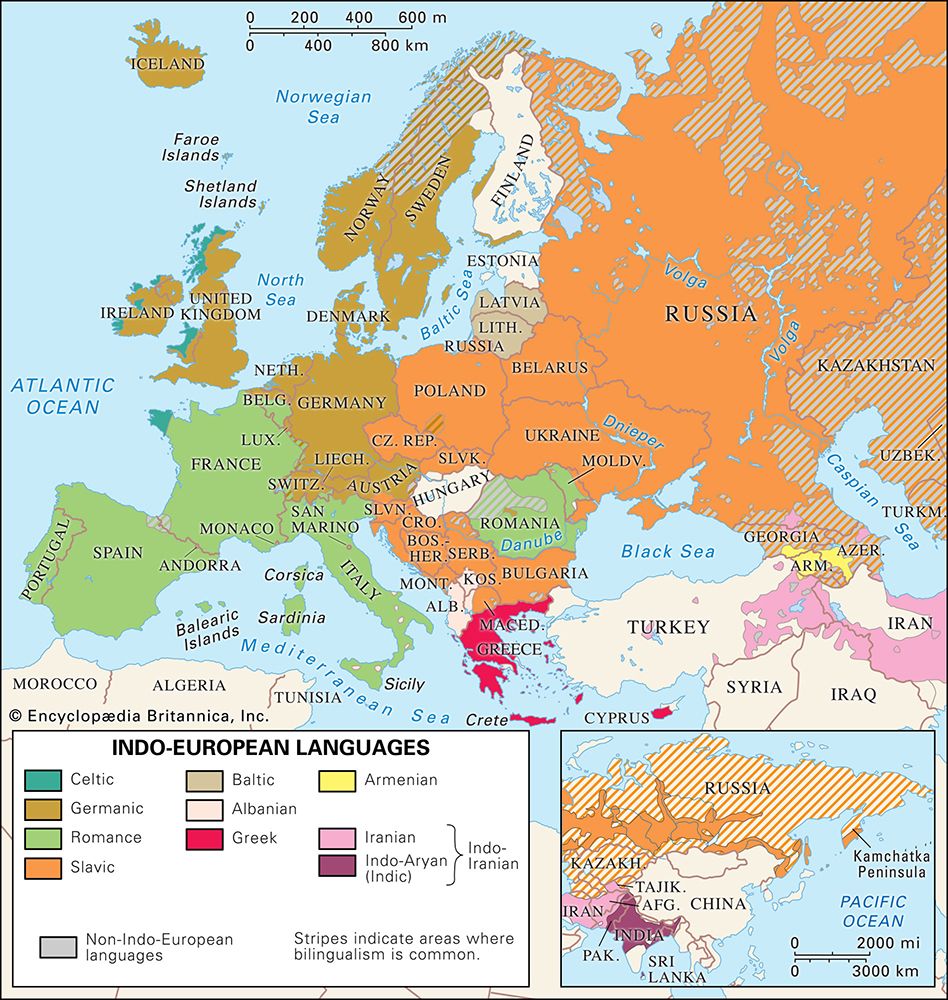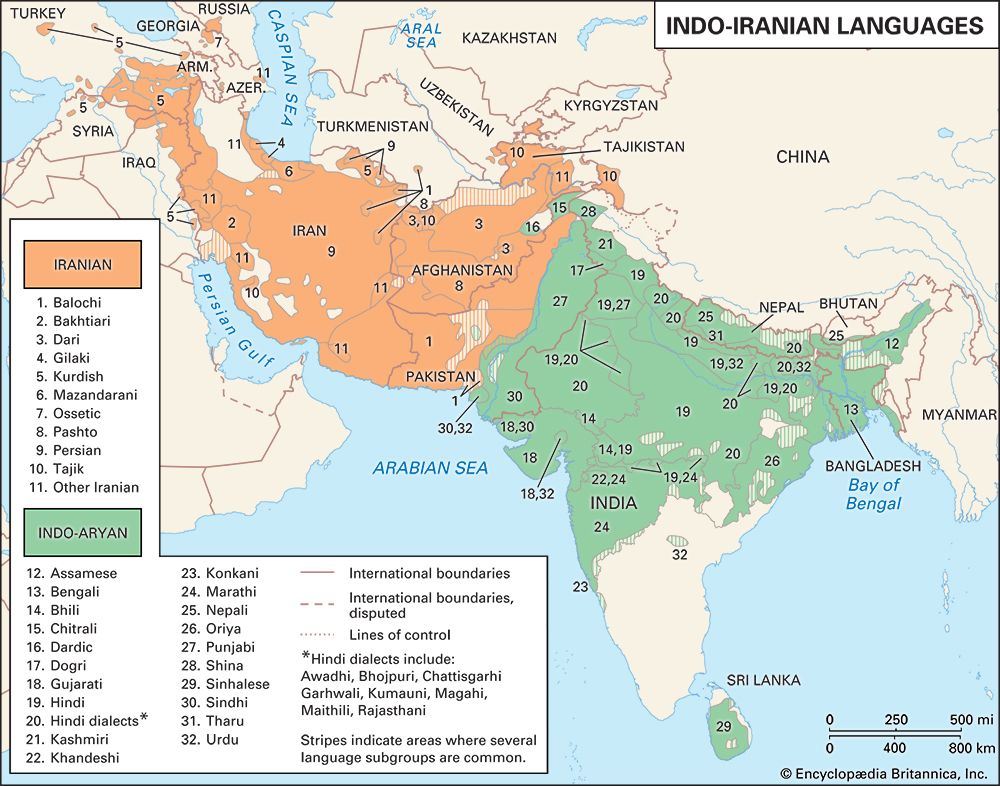Characteristics of the Iranian languages
All Iranian languages show in their basic elements the characteristic features of an Indo-European language. Apart from the extensive borrowing of Arabic words in Modern Persian, the Iranian languages have scarcely been affected by unrelated languages, with the notable exception of Ossetic, which has been strongly influenced by the neighbouring Caucasian languages. Some dialects of Tajik have been very receptive to Uzbek elements. In the case of languages in contact with Indian civilization, the most noticeable non-Iranian feature often taken over is the Indo-Aryan series of retroflex sounds. Those sounds are foreign to Indo-Aryan itself, being a result of the influence of the Dravidian languages.
The elaborate phonological and morphological structure of the Indo-European parent language has been progressively simplified in the development of the Iranian languages. The basic phonological structure of Common Old Iranian has on the whole been maintained, but the morphological system has continued to be simplified. There has been a constant move in almost all Iranian languages toward an analytic structure; i.e., the use of prepositions and word order rather than case endings to indicate grammatical relationships.
Phonology
The most characteristic features of the Iranian phonological system are those that distinguish it from the Indo-Aryan system. These are the development of various fricative sounds (indicated in phonetic symbols as x, f, θ, and later ɤ, β, ð), and of the voiced sibilant sounds z and ž. Even in Iranian, however, these sounds did not persist universally. In western Middle Iranian the θ sound was lost, and it is rare in the modern languages. In Pashto the inherited f sound has been discarded. Balochi, except in the extreme east, is entirely without fricatives. Voiced bilabial and dental fricative sounds (β and ð) were recorded in some early manuscripts of Modern Persian, but they became b and d by the 13th century
Two negative features have also resulted in differentiation between Indo-Aryan and Iranian. One is the result of the coalescence in Proto-Iranian of aspirated and unaspirated voiced stops. Thus, Indo-European *b and *bh were maintained in contrast in Indo-Aryan as b and bh, but they fell together in Iranian as b. That resulted in an alteration of the phonological structure because the number of consonant contrasts (oppositions) was reduced. The other negative feature is the absence of the retroflex consonants from Iranian except as a later importation in contiguous regions.
Other divergences in development, such as the change of an s sound to h in Iranian, brought about a difference in distribution rather than in structure because h developed also in Indo-Aryan but from Indo-Iranian *źh and *gh before front vowels (e.g., e and i).
In Old Iranian the stress lay on the next to the last syllable if it was heavy (i.e., contained a long vowel or was closed by a consonant)—otherwise on the preceding syllable. With the loss of final unstressed vowels in the development of many Iranian languages, the stress often came to be on the final syllable. End stress is characteristic of Modern Persian.
Grammar
In Old Persian the Indo-European inflectional system appears considerably simplified. In particular, the genitive and the dative coalesced into one case and the instrumental and ablative into another. Moreover, in the plural the nominative and accusative cases are not distinguished. That reduced system is still found in the Middle Iranian period in Old Khotanese and to a certain extent in Sogdian. Eastern Iranian is in that respect more conservative than western. By the Middle Iranian period, western Iranian had abandoned nominal (noun, adjective, pronoun) inflection altogether, as is the case with Middle and Modern Persian and with Parthian. In some languages, both western and eastern, two or, rarely, three cases survive. Ossetic is quite exceptional in maintaining an elaborate case system; it is partly a result of secondary, purely Ossetic developments.
The elaborate conjugational system of the Indo-European verb followed a similar path to disintegration. In particular, the whole past tense system was given up by the Middle Iranian period. Only a few relics remain of the Indo-European system, such as the partial survival of the augment (a prefixed vowel or lengthening of the initial vowel) in the Sogdian imperfect tense. But a new past tense system developed, based on the old past participle, often combined with auxiliary verbs. Many languages distinguish between transitive and intransitive verbs in the past tense system; and in some, such as Khotanese and Pashto, even gender and number are distinguished.
The present tense system was far better preserved. The dual number was in retreat in Old Iranian and is not attested later. The middle voice, a form that indicates that a person or thing both performs and is affected by the action represented, was generally abandoned by the Middle Iranian period, although middle voice inflection is well represented in Khotanese. With these qualifications, the endings of the present indicative (active) have been generally well preserved. A variety of imperative, subjunctive, and optative forms, partly based on inherited forms and partly the result of innovation, is found especially in the eastern languages, including Ossetic.
Rigidity of word order is, on the whole, most characteristic of those languages, such as Persian, that have gone furthest in the reduction of the inherited morphological system.
Vocabulary
The Islamic conquest of Iran during the 7th century entailed not only a change of religion but also a change of language. The sacred language of Islam was Arabic, and the proportion of Arabic words used in Persian rapidly increased until it reached something like the 40 to 50 percent of the present day. Before the introduction of the Arabic element, most loanwords were mainly from other Iranian languages. Most familiar is the extensive borrowing from Median found in Old Persian. In later periods, Modern Persian borrowed words extensively from Turkish and from European languages. Persian is itself the donor language in the case of the other Iranian languages, all of which have drawn upon its vocabulary.
Buddhism was similarly responsible for the large proportion of Indo-Aryan words, both Sanskrit and Prakrit, found in Sogdian and especially in Khotanese. A considerable Indian element occurs in the vocabulary of those modern Iranian languages that have been or are in contact with modern Indo-Aryan languages in the northwest, such as Lahnda and Sindhi. There the Dardic languages have also been influential. Balochi has also borrowed from Brahui, a Dravidian language spoken in Balochistan in Pakistan.
Ossetic occupies an exceptional position. Most of its Persian and Arabic borrowings have come to it through Turkish, but more striking are the large number of words borrowed from the Caucasian languages, especially Georgian. In modern times, Ossetic continues to be influenced by Russian.












